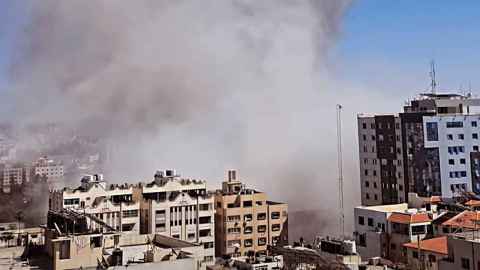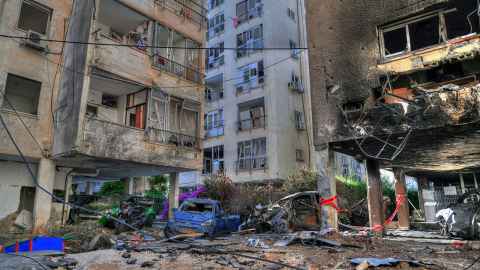Israel v Hamas: Changing contexts and new challenges
25 May 2021
Opinion: Lethal exchange between Israel and Hamas has stopped for now. But this latest crisis has exposed changing support from abroad, writes Stephen Hoadley.

The Israel-Hamas ceasefire offers an opportunity to reflect on its wider contexts. What has the latest lethal exchange accomplished for each antagonist? Where do the contesting parties go from here? What role will their backers – principally the US and Iran – play in future? What new challenges loom for all concerned actors?
Looking forward, a brief look back is instructive. This violent clash was not the first but the fifth in a generation. Palestinian uprisings against alleged Israeli oppression flared up in 1987, 2000, 2008, and 2014. Israel’s robust response resulted in death tolls ranging from 1000 to more than 3000, mostly Palestinian. So the May 2021 clash of 11 days duration, killing 246 Palestinians and 12 Israelis, was, by contrast, relatively mild. Israel’s precision weapons, advance warnings to targets, and the Iron Dome missile interception system have limited injury to both populations. US pressure and Egyptian mediation helped persuade the antagonists to stop shooting and, it is hoped, to start talking.
The political outcome? Both Israel and Hamas have claimed ‘victory’. Israel can claim that Hamas’s military infrastructure is severely damaged and many of its top leaders and best fighters are dead. Israel has clearly demonstrated its military-technical superiority and ability to minimise damage and injury to its assets and citizens. Hamas can claim to have emerged as the undisputed champion of Palestinian aspirations, having politically sidelined the rival Fatah party that leads the Palestinian Authority in the West Bank. As the maxim goes, insurgents win if they don’t lose, and Hamas has survived intact, albeit wounded.
The fundamental issues remain almost exactly as they were posed a month ago. Hamas denies the legitimacy and indeed the existence of the state of Israel and demands the right of Palestinians to return to Israel. Israel regards Hamas as an existential enemy employing terrorist tactics and using Gaza civilians as human shields. Israel continues facilitating Israeli settlements in the West Bank and benefiting from USD3.5 billion per year in aid, and diplomatic cover, from the US. Hamas continues to arm its militia with undisclosed caches of rockets, explosives, and small arms smuggled from Iran with Lebanese Hezbollah’s support. Both claim exclusive sovereignty over East Jerusalem.
Given that none of these binary disagreements was resolved by the May 2021 exchange of fire, a recurrence of violence is likely in future. When, where and in what form cannot be predicted precisely but it is likely to resemble its five predecessors. And the outcome is likely to be similar: rock-throwing, rockets and armed tunnel infiltration from Gaza, and artillery, air and sniper strikes from Israel, causing major damage to Gaza’s infrastructure and injury to civilians and modest damage to Israel.
Changes are in motion that may alter this prognosis. They may be summed up in three words: nationalism, legitimacy, and mobilization. First, Israel’s governing coalitions have adopted an increasingly nationalist, security-oriented posture, one which the recent rocket attacks can only intensify. Prime Minister Benjamin Netanyahu’s hardline leadership is strengthened, at least in the short term, as is the influence of Zionist parties that support him. Israel’s acceptance of the ‘two state solution’ appears to be politically unfeasible in the current climate. Compromise with the Palestinians, themselves ever more inclined to nationalistic self-identity, is a disappearing vision.
The legitimacy of the policies of the government of Israel is eroding among not only former European supporters but also elements of the US Democratic Party. President Biden’s qualified support has replaced President Trump’s uncritical posture. Further, the Abraham Accords are in jeopardy as Arab governments such as the UAE, Bahrain and Morocco paused in their promising diplomatic negotiations with Israel, and have openly criticised Israel's military action in Gaza. Contrariwise, the legitimacy of Palestinian grievances is growing among Western publics previously indifferent.
Third, the new element that appeared in May, unlike in previous episodes, was the mobilisation of Palestinian who are Israeli citizens. They enjoy most (but not all) of the privileges of Israeli citizenship, and modest prosperity, and have been heretofore relatively quiescent. They have voted for moderate Arab List political leaders who last month were poised to join the ruling coalition.

The mobilisation of youthful Palestinian protesters impatient with the long-running and ineffective standoff and their alleged second-class status, and goaded by provocations by hyper-Zionist young men, is amplifying inside Israel the demands of those in Gaza and West Bank…and those of the Arab world generally. As critical mass accumulates, the popular demonstrations have the potential to alter the political dynamic. The rejection of enervating compromises will discredit the current generation of political leaders in both Israel and in the Palestinian Authority. But as happened in the Arab Spring, moderates may be overtaken by more extreme leaders with simple, uncompromising appeals and unscrupulous tactics. This will raise the potential for violent public confrontations within Israel and the West Bank.
Hamas leaders are well positioned by inclination, experience and organisation to exploit this new volatility. Their aim will be to assert leadership of the popular confrontations and to bring Israel to a standstill by fomenting demonstrations and general strikes. Whether this change of tactical direction from rocket barrages to stoking mass civil disobedience will induce Israel to ease the occupation and blockade and facilitate Palestinian statehood remains debatable. Some analysts doubt that Hamas leaders have the mental and organisational flexibility to lead a political movement, or that their backer, Iran, would be in favour of abandoning militant tactics.
In sum, little has changed in the short run. Gaza’s infrastructure will be rebuilt, and Israel’s missile interception system replenished, both courtesy of United States generosity. Some Arab governments will gravitate to Israel not only because it is in their economic interest to do so but also to forge an informal united front against Iran and its terrorist proxies. And Iran will continue its clandestine support of Hamas, Islamic Jihad, and Hezbollah, and its assistance to a hostile Syria, both bolstered by Russian military aid and hybrid warfare tactics.
But in the longer-term trends of growing nationalism, changing legitimacies, and popular mobilisation suggest the transformation of the Palestinians from impotence to activism under either Hamas leaders or champions yet to emerge from radicalised youth. This may be a ‘Palestinian Spring’. Israel’s military prowess may be irrelevant in the new paradigm of socio-political confrontation. Israel may be severely challenged by ethno-social divisions and political deadlock within at a time of declining international legitimacy and rising nationalism and mobilisation.
Stephen Hoadley is Associate Professor of Politics and International Relations in the Faculty of Arts.
This article reflects the opinion of the author and not necessarily the views of the University of Auckland.
Used with permission from Newsroom Israel v Hamas: Changing contexts and new challenges 25 May 2021.
Media queries
Alison Sims | Research Communications Editor
DDI 09 923 4953
Mob 021 249 0089
Email alison.sims@auckland.ac.nz